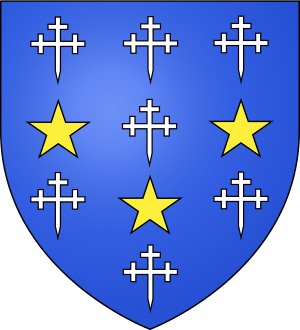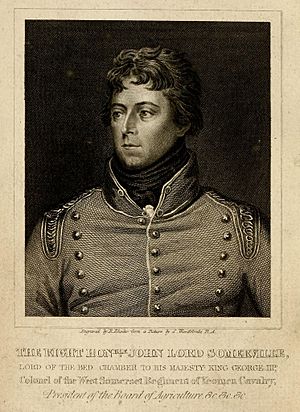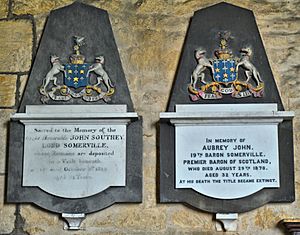Lord Somerville facts for kids
The title Lord Somerville is a special rank in the Peerage of Scotland. It was likely created around 1435 for Thomas Somerville. He was an important judge in Scotland at that time.
For a while, the title was not officially used. This happened after Scotland and England joined their crowns in 1606. But in 1723, the House of Lords officially recognized the title again. This was for James Somerville, who became the 13th Lord. The exact numbering of the Lords can sometimes be a bit confusing. Different history books might count them slightly differently.
Contents
The Somerville Family Story
The Somerville family has a long and interesting history. They believe they are related to William de Somerville. He was given land called Carnwath by David I of Scotland in the 1100s.
The Worm of Linton Legend
A family history was written in 1679 by James Somerville, 11th Lord Somerville. He shared a famous story about Sir John Somerville. In 1174, William the Lion made John Somerville a baron. This was because John killed a huge monster called the Worm of Linton.
The worm was about three Scots yards long. It looked like a giant snake. Sir John bravely tracked the beast for several days. He finally killed it with a long, iron-tipped spear. The spear had a special spinning wheel near its point. Because of this brave act, the Somervilles used a wyvern (a dragon-like creature) in their family crest.
The poet Blind Harry also wrote about the Somervilles. He mentioned Walter Somerville and his son David. They were made knights by Alexander III of Scotland at the Battle of Biggar.
Somerville Family Homes
The Somerville family later lived at Drum House. This large estate is near Edinburgh. They got Drum House when Sir Walter Somerville married the daughter of Sir John Herring.
The family sold their land at Carnwath in the 1500s. Hugh Somerville, the 7th Lord, built a strong tower house at Drum in 1585. Later, between 1726 and 1734, a beautiful new mansion was built. It was designed by the famous architect William Adam. The Drum estate was sold in 1862.
Ancient Roots of the Somervilles
The earliest known ancestor of the family was Sir Gualter de Somerville. He was a Norman knight. He came to England with William the Conqueror. For his help, he received land in Stafford and Aston Somerville.
One of Gualter's sons, William de Somerville, was a close friend of King David I of Scotland. King David gave him the barony of Carnwath in Lanarkshire. William also gained the barony of Linton. The Somervilles continued to be close to Scottish royalty. They also married into other important Scottish families.
An English poet named William Somervile (1675–1742) was also a descendant of Walter de Somerville.
Notable Somerville Family Members
The Somervilles of Cambusnethan were another branch of the family. Among their descendants were:
- William Somerville (1771–1860), a doctor.
- Mary Somerville (1780–1872), his wife and cousin. She was a brilliant scientist and writer. She studied many different subjects.
Lords Somerville List
Here is a list of the Lords Somerville:
- Thomas Somerville, 1st Lord Somerville (c. 1370–1444)
- William Somerville, 2nd Lord Somerville (c. 1400–1456)
- John Somerville, 3rd Lord Somerville (d. 1491)
- John Somerville, 4th Lord Somerville (c. 1484–1523)
- Hugh Somerville, 5th Lord Somerville (c. 1484–1549)
- James Somerville, 6th Lord Somerville (c. 1518–1569)
- Hugh Somerville, 7th Lord Somerville (1547–1597)
- Gilbert Somerville, 8th Lord Somerville (1568–1618)
- Hugh Somerville, 9th Lord Somerville (c. 1573–1640)
- James Somerville, 10th Lord Somerville (1595–1677)
- James Somerville, 11th Lord Somerville (1632–1693)
- James Somerville, 12th Lord Somerville (1674–1709)
- James Somerville, 13th Lord Somerville (1698–1765)
- James Somerville, 14th Lord Somerville (1727–1796)
- John Southey Somerville, 15th Lord Somerville (1765–1819)
- Mark Somerville, 16th Lord Somerville (1784–1842)
- Kenelm Somerville, 17th Lord Somerville (1787–1864)
- Hugh Somerville, 18th Lord Somerville (1839–1868)
- Aubrey John Somerville, 19th Lord Somerville (1838–1870)




